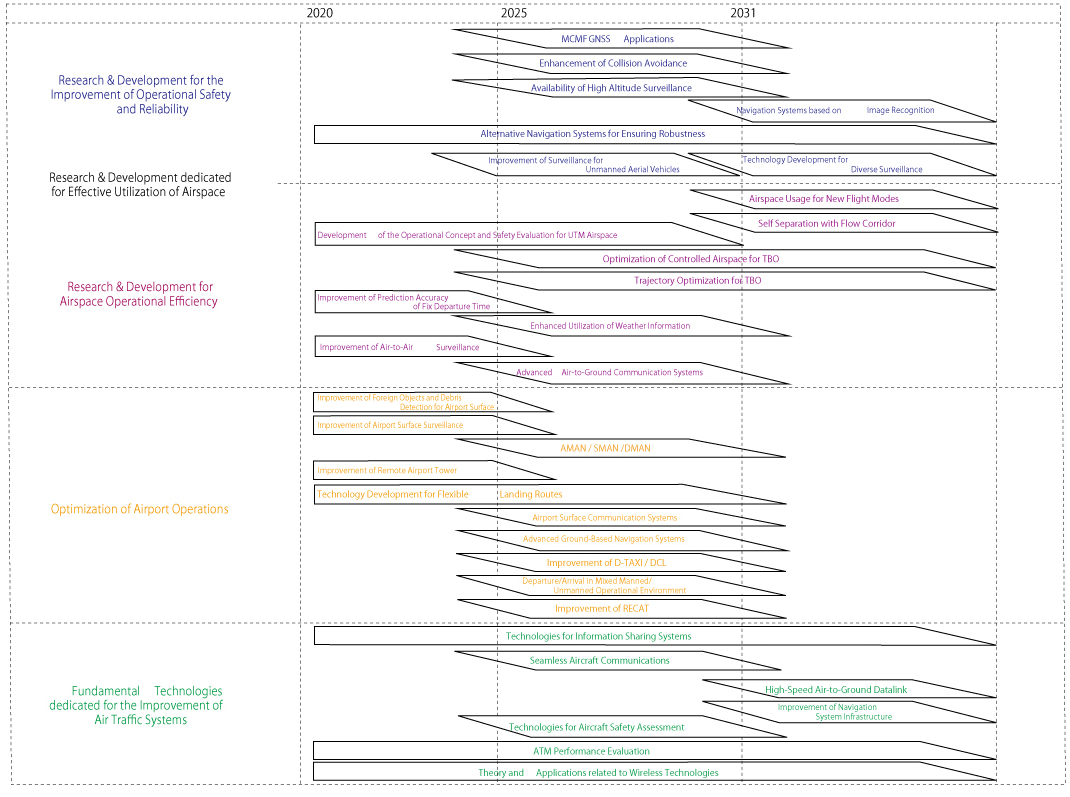Long-term Vision
Research and Development Long-Term
Vision June 2019
Study Committee for Research and Development Long-Term Vision
ENRI is a central research institute for the air traffic systems in Japan. One of ENRI's prime tasks is to improve the quality of life by through the development of science and technology by understanding issues related to air traffic systems. Active participation in standardization activities is also considered as a high priority for setting the technical standards that ensure global interoperability.
The 6th edition of Global Air Navigation Plan (GANP) is being set at the International Civil Aviation Organization (ICAO), and the 13th Air Navigation Conference (AN-Conf/13) was held in October 2018 ahead of the 40th ICAO General Assembly. Research and development of unmanned aircraft systems and supersonic aircraft are being actively carried out both in Japan and overseas, and technological innovation is expected to advance in these fields in the future. As the demand for world aviation rapidly changes, ENRI revised its Research and Development Long-Term Vision in June 2019, creating a long-term vision for research for the new era.
In a future air transportation system, in addition to conventional aircraft, various aerial vehicles with different performance characteristics and purposes are expected to operate, requiring flexible airspace management that can accommodate this greater diversity. For example, a mixed-equipage environment consists of large unmanned aircraft systems, supersonic aircraft, sub-orbital vehicles at high altitudes, small unmanned aerial vehicles and urban air mobility vehicles at low altitudes is anticipated in such a system. Furthermore, air traffic management will become highly advanced where the concept of Trajectory Based Operations (TBO) would become a reality. TBO considers the interference between aircraft and operational efficiency to determine and adjust the flight trajectory of an aircraft in advance, which then operates on that trajectory in a predetermined time. Hence, TBO requires the introduction of various measures.
The Research and Development Long-Term Vision is broadly categorized into four categories: effective use of airspace by improving operational safety and reliability; increasing the efficiency of airspace operations; improving the efficiency of airport operations; and developing fundamental technologies for the advancement of air traffic control systems. Major constituent technologies for which research and development ought to be promoted are summarized in the ENRI Research and Development Long-Term Vision Roadmap (see Appendix).
This revision was carried out with reference to the progress of CARATS, the ICAO GANP issued in September 2016, and the discussions of the AN-Conf/13 in October 2018. The actual research plans at ENRI will be dynamic and flexible, considering changes in the situation surrounding air traffic control systems, while referring to this Long-Term Vision. To promote research activities effectively, ENRI is determined to collaborate with industries, academia, and government to carry out research activities in the field of air traffic systems. ENRI believes that expanding and strengthening collaboration, including collaborative research carried out with universities and research institutions, will yield maximum research results.
Electronic Navigation Research Institute(ENRI)
-Roadmap for Research and Debelopment Long-Term Vision

- Research & Development dedicated for Effective Utilization of Airspace
- Research & Development for the Improvementof Operational Safety and Reliability
- MCMF GNSS Applications: around 2025-around 2031
- Enhancement of Collision Avoidance: around 2025-around 2031
- Availability of High Altitude Surveillance: around 2025-around 2031
- Navigation Systems based on Image Recognition: around 2031-
- Alternative Navigation Systems for Ensuring Robustness: 2020-
- Improvement of Surveillance for Unmanned Aerial Vehicles: around 2025-around 2031
- Technology Development for Diverse Surveillance: around 2031-
- Research & Development for Airspace Operational efficiency
- Airspace Usage for New Flight Modes: around 2031-
- Self Separation with Flow Corridor: around 2031-
- Development of the Operational Concept and Safety Evaluation for UTM Airspace: 2020-around 2031
- Optimization of Controlled Airspace for TBO: around 2025-
- Trajectory Optimization for TBO: around 2025-
- Improvement of Prediction Accuracy of Fix Departure Time: 2020-around 2025
- Enhanced Utillzation of Weather Information: around 2025-around 2031
- Inprovement of Air-to-Air Surveillance: 2020-around 2025
- Advenced Air-to-Ground Communication Systems: around 2025-around 2031
- Research & Development for the Improvementof Operational Safety and Reliability
- Optimization of Airport Operations
- Improvement of Foreign Objects and Debris Dection for Airport Suface: 2020-around 2025
- Improvement of Airport Surface Surveillance: 2020-around 2025
- AMAN/SMAN/DMAN: around 2025-around 2031
- Improvement of Remote Airport Tower: 2020-around 2025
- Technology Development for Flexible Landing Routes: 2020-around 2031
- Airport Surface Communication Systems: around 2025-around 2031
- Advanced Ground-Based Navigation Systems: around 2025-around 2031
- Improvement of D-TAXI/DCL: around 2025-around 2031
- Departure/Arrival in Mixed Manned/Unmanned Operational environment: around 2025-around 2031
- Improvement of RECAT: around 2025-around 2031
- Fndamental Technologies dedicated for the imporovement of Air Traffic Systems
- Technologies for Information Sharing Systems: 2020-
- Seamless Aircraft Communications: around 2025-around 2031
- High-Speed Air-to-Ground Datalink: around 2031-
- Improvement of Navigation System Infrastructure: around 2031-
- Technologies for Aircrafts Safety Assessment: around 2025-around 2031
- ATM Performance Evaluation: 2020-
- Theory and Applications related to Wireless Technologies: 2020-